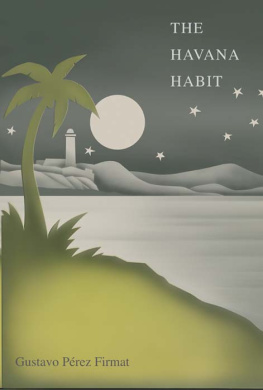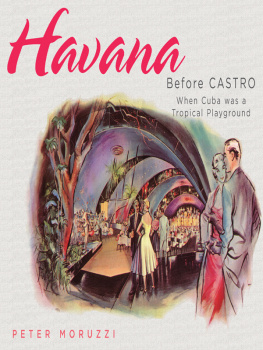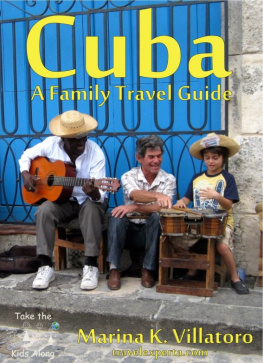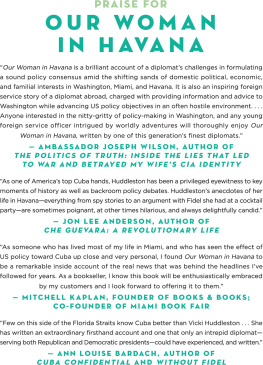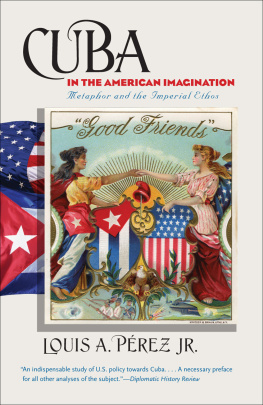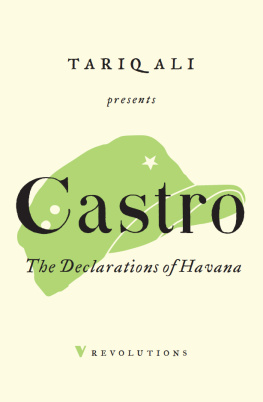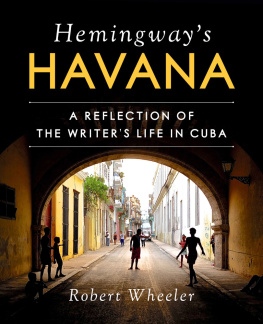The Havana Habit
Yale UNIVERSITY PRESS NEW HAVEN & LONDON

Copyright 2010 by Gustavo Prez Firmat. All rights reserved.
This book may not be reproduced, in whole or in part, including illustrations, in any form (beyond that copying permitted by Sections 107 and 108 of the U.S. Copyright Law and except by reviewers for the public press), without written permission from the publishers.
Ill See You in C-U-B-A by Irving Berlin copyright 1920 by Irving Berlin.
Copyright renewed. International copyright secured. All rights reserved. Reprinted by permission. Mama Inez by Eliseo Grenet and L. Wolfe Gilbert. Used by permission of Edward B. Marks Company. A-Ding, A-Dong by Bobby Capo and Al Stillman. Used by permission of Edward B. Marks Company. You Too, You Too by Felix M. Rodriguez and Marian Banks. Used by permission of Edward B. Marks Company. Mashed Potato Time. Words and Music by William Garrett, Robert Bateman, Georgia Dobbins, Brian Holland, Freddie Gorman and Kal Mann 1962 (Renewed 1990) Jobete Music Co., Inc., Stone Agate Music (A Division of Jobete Music Co., Inc.), and EMI Blackwood Music Inc. All rights for Jobete Music Co., Inc., and Stone Agate Music (A Division of Jobete Music Co., Inc.) Controlled and Administered by EMI April Music Inc. All rights reserved. International Copyright Secured. Used by Permission. Reprinted by permission of Hal Leonard Corporation.
Yale University Press books may be purchased in quantity for educational, business, or promotional use. For information, please e-mail (U.K. office).
Set in Janson type by Integrated Publishing Solutions. Printed in the United States of America.
Library of Congress Cataloging-in-Publication Data
Prez Firmat, Gustavo, 1949
The Havana habit / Gustavo Prez Firmat.
p. cm.
Includes bibliographical references and index.
ISBN 978-0-300-14132-0 (clothbound : alk. paper) 1. United StatesCivilizationCuban influences. 2. CubaIn popular culture. 3. Popular cultureUnited States. 4. Popular cultureCuba. 5. National characteristics, Cuban. 6. CubaSocial life and customs. 7. Havana (Cuba)Social life and customs. 8. AmericansTravelCubaHistory. I. Title.
E169.12.P483 2010
306.0973dc22 2010017498
A catalogue record for this book is available from the British Library.
This paper meets the requirements of ANSI/NISO Z39.41992
(Permanence of Paper).
10 9 8 7 6 5 4 3 2 1
For Mary Anne
Cubatheres magic in the name alone.
Lawrence Tibbett in The Cuban Love Song (1931)
Acknowledgments
This is a short book that was long in the making, and I owe a debt of gratitude to many people and institutions. The germ of the book was contained in a lecture I delivered at the Center for Free Inquiry of Hanover College in 2003. Since then, Ive had the opportunity to develop my ideas before audiences at Dickinson College, Western Michigan University, the University of Delaware, Marist College, and the University of Louisville. The Cristbal Daz Ayala Collection at Florida International University provided not only access to its rich holdings on Cuban music but a travel fellowship that allowed me to use them. Mayra Nemeth and Vernica Rodrguez, the curators of the Daz Ayala Collection, went out of their way to point me to the relevant materials. The Institute of Latin American Studies at Columbia University also provided travel and research funds. David Frasier and Zach Downey of the Lilly Library at Indiana University kindly furnished copies of hard-to-find sheet music. As in the past, Esperanza de Varona, Mara Estorino Dooling, and Lesbia Varona of the University of Miamis Cuban Heritage Collection answered my queries promptly and efficiently.
Jorge Olivares once again performed the fraternal though not thankless task of reading another of my manuscripts. For many years Isabel Alvarez Borland, Roberto Gonzlez Echevarra, Ricardo Castells, and Rolando Prez have been my friends and interlocutors. Robertos support of the project from conception to completion was crucial. John Koegel generously shared with me his vast knowledge of Latin American music. Tony Hyman, curator of the National Cigar Museum, did the same for cigar advertising and memorabilia. A Southern dinner with Lori Carlson and Oscar Hijuelos provided timely encouragement. Jonathan Brent believed in the book when it was little more than wishful thinking. Sarah Miller, my editor at Yale, saw it through to its present form with enthusiasm and care. Laura Jones Dooley was a tactful and precise copyeditor.
I would also like to acknowledge the contribution of the two readers for Yale University Press, whose mostly sensible suggestions I have mostly followed. The students in my undergraduate class on Cuba and the United States at Columbia have been a joy to teach and learn from. Finally, Mary Anne Prez Firmat, thanks to whom I havent had to set foot in a library in years, collaborated in the writing of this storyour storyin ways mentionable and unmentionable.
Introduction
SO NEAR AND YET SO FOREIGN
In Youll Never Get Rich (1941), the first of two musicals in which Fred Astaire teamed up with Rita Hayworth, Fred plays a Broadway dance director who agrees to put on a show at the army base where he is stationed. During the rehearsal, he instructs the stagehands: I want a tree right hereand a fake palm tree appears; Bring me a houseand a Spanish-style facade slides onto the stage; Boys, now I want an oceanand the boys bring in the backdrop: a large image of the entrance to Havana harbor as viewed from the seaside avenue called El Malecn. Once the scenery is in place, Rita Hayworth appears, looking seorita-lovely in a sheer black dress with a ruffled skirt. Leaning against the palm tree, Fred launches into Cole Porters So Near and Yet So Far, whose lyric seems to allude both to Rita and to Havana. After Fred sings, he and Rita dance the most elegant rumba ever captured on film ().

Fig. 1. Still from Youll Never Get Rich. YOULL NEVER GET RICH Copyright 1941, renewed 1969 Columbia Pictures Industries, Inc. All Rights Reserved. Courtesy of Columbia Pictures.
Freds creation of a mock Havana in a movie that otherwise has nothing to do with Cubahe is about to be shipped off to Panamanot only puts on display American perceptions about Latin Americarhythmic, romantic, ficklebut illustrates the centrality of Cuba to these perceptions. No other Latin American nation has left as pervasive an imprint on this countrys cultural landscape as that long island in the Caribbean. Jon Lee Anderson, the author of a book about Che Guevara, puts it this way: I think Cuba is part of our psyche, our own historical landscape, and it inhabits part of our imagination as no other place does. Anderson is right. Few nations anywhere have enjoyedand enduredas close a relationship with the United States. For more than two centuries, the two countries have been linked by what William McKinley in 1899 termed ties of singular intimacy, a close but contentious relationship that has produced rapprochements, disappointments, misunderstandings, embargos, embarques, and, every once in a while, a military occupation. If Cubans have always regarded los americanos with a mixture of fascination, fear, lust, disdain, and envy, Americans, for their part, have looked on Cubans with mixed feelings of their own. Ever since John Quincy Adams compared the island to an apple ready to drop into the lap of the United States, Cuba has been the object, and sometimes the target, of American desires. For Americans, Cuba has been both mirror and mirage: a magnified reflection of domestic anxieties as well as a beckoning oasis of otherness.
Next page
